DEEP LEARNING
Andrew Beam, PhD
Instructor
Department of Biomedical Informatics
Harvard School of Public Health
November 29th, 2017

twitter: @AndrewLBeam
GOAL OF THIS TALK


SHAMELESS ADVERTISEMENT

We are offering BMI 707 in the spring second session. In this class you will:
- Implement state of the art deep learning models:
- CNNs, RNNs, MLPs, auto encoders, etc
- Learn tensorflow on super fast cloud-based TPUs (tensor processing units)
- Hear guest lectures from leading folks at Google Brain
- Learn how to apply these models to real biomedical data
If you like today's deep learning tapas, sign up for our course and have the full meal
Additional Resources

http://beamandrew.github.io

WHY DEEP LEARNING?
DEEP LEARNING HAS MASTERED GO





DEEP LEARNING HAS MASTERED GO


Source: https://deepmind.com/blog/alphago-zero-learning-scratch/

Human data no longer needed
DEEP LEARNING HAS MASTERED GO


DEEP LEARNING HAS MASTERED GO



DEEP LEARNING CAN DIAGNOSE PATIENTS





Medical imaging already is being changed
DEEP LEARNING CAN DIAGNOSE PATIENTS






Medical imaging already is being changed
DEEP LEARNING CAN DIAGNOSE PATIENTS

What does this patient have?
A six-year old boy has a high fever that has lasted for three days. He has extremely red eyes and a rash on the main part of his body in addition to a swollen and red strawberry tongue. Remaining symptoms include swollen lymph nodes in the neck and Irritability
DEEP LEARNING CAN DIAGNOSE PATIENTS

What does this patient have?
A six-year old boy has a high fever that has lasted for three days. He has extremely red eyes and a rash on the main part of his body in addition to a swollen and red strawberry tongue. Remaining symptoms include swollen lymph nodes in the neck and Irritability

Image credit: http://colah.github.io/posts/2015-08-Understanding-LSTMs/
DEEP LEARNING CAN DIAGNOSE PATIENTS

What does this patient have?
A six-year old boy has a high fever that has lasted for three days. He has extremely red eyes and a rash on the main part of his body in addition to a swollen and red strawberry tongue. Remaining symptoms include swollen lymph nodes in the neck and irritability

EVERYONE IS USING DEEP LEARNING



WHAT IS A NEURAL NET?

WHAT IS A NEURAL NET?

A neural net is made up of 3 things
WHAT IS A NEURAL NET?

A neural net is made up of 3 things
The network structure
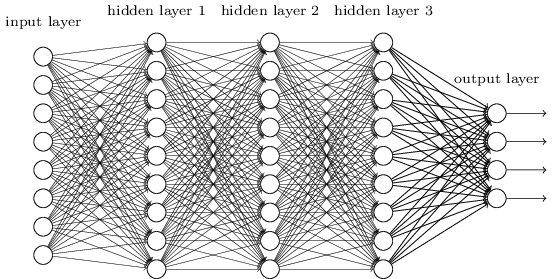
WHAT IS A NEURAL NET?

A neural net is made up of 3 things
The network structure
The loss function

WHAT IS A NEURAL NET?

A neural net is made up of 3 things
The network structure
The optimizer


The loss function
NEURAL NETWORK STRUCTURE


NEURAL NET STRUCTURE

A neural net is a modular way to build a classifier
Inputs
Output
WHAT IS AN ARTIFICIAL NEURON?

The neuron is the basic functional unit a neural network
Inputs
Output
WHAT IS AN ARTIFICIAL NEURON?

The neuron is the basic functional unit a neural network
Inputs
Output
WHAT IS AN ARTIFICIAL NEURON?

The neuron is the basic functional unit a neural network
A neuron does two things, and only two things
WHAT IS AN ARTIFICIAL NEURON?

The neuron is the basic functional unit a neural network
Weight for
A neuron does two things, and only two things
Weight for
1) Weighted sum of inputs
WHAT IS AN ARTIFICIAL NEURON?

The neuron is the basic functional unit a neural network
Weight for
A neuron does two things, and only two things
Weight for
1) Weighted sum of inputs
2) Nonlinear transformation
WHAT IS AN ARTIFICIAL NEURON?


is known as the activation function, and there are many choices
Sigmoid


Hyperbolic Tangent

WHAT IS AN ARTIFICIAL NEURON?

Summary: A neuron produces a single number that is a nonlinear transformation of its input connections
A neuron does two things, and only two things
= a number
NEURAL NETWORK STRUCTURE

Inputs
Output
Neural nets are organized into layers
NEURAL NETWORK STRUCTURE

Inputs
Output
Input Layer
Neural nets are organized into layers
NEURAL NETWORK STRUCTURE

Inputs
Output
Neural nets are organized into layers
1st Hidden Layer
Input Layer
NEURAL NETWORK STRUCTURE

Inputs
Output
Neural nets are organized into layers
A single hidden unit
1st Hidden Layer
Input Layer
NEURAL NETWORK STRUCTURE

Inputs
Output
Input Layer
Neural nets are organized into layers
1st Hidden Layer
A single hidden unit
2nd Hidden Layer
NEURAL NETWORK STRUCTURE

Inputs
Output
Input Layer
Neural nets are organized into layers
1st Hidden Layer
A single hidden unit
2nd Hidden Layer
Output Layer
LOSS FUNCTIONS

Output
Output Layer
We need a way to measure how well the network is performing, e.g. is it making good predictions?
LOSS FUNCTIONS

Output
Output Layer
We need a way to measure how well the network is performing, e.g. is it making good predictions?
Loss function: A function that returns a single number which indicates how closely a prediction matches the ground truth label
LOSS FUNCTIONS

Output
Output Layer
We need a way to measure how well the network is performing, e.g. is it making good predictions?
small loss = good
big loss = bad
Loss function: A function that returns a single number which indicates how closely a prediction matches the ground true label
LOSS FUNCTIONS

A classic loss function for binary classification is binary cross-entropy
LOSS FUNCTIONS

A classic loss function for binary classification is binary cross-entropy
| y | p | Loss |
|---|---|---|
| 0 | 0.1 | 0.1 |
| 0 | 0.9 | 2.3 |
| 1 | 0.1 | 2.3 |
| 1 | 0.9 | 0.1 |
OUTPUT LAYER & LOSS

Output Layer
The output layer needs to "match" the loss function
- Correct shape
- Correct scale
OUTPUT LAYER & LOSS

Output Layer
The output layer needs to "match" the loss function
For binary cross-entropy, network needs to produce a single probability
OUTPUT LAYER & LOSS

Output Layer
The output layer needs to "match" the loss function
One unit in output layer to represent this probability
For binary cross-entropy, network needs to produce a single probability
OUTPUT LAYER & LOSS

Output Layer
The output layer needs to "match" the loss function
One unit in output layer to represent this probability
For binary cross-entropy, network needs to produce a single probability
Activation function must "squash" output to be between 0 and 1

OUTPUT LAYER & LOSS

Output Layer
The output layer needs to "match" the loss function
One unit in output layer to represent this probability
For binary cross-entropy, network needs to produce a single probability
Activation function must "squash" output to be between 0 and 1

We can change the output layer & loss to model many different kinds of data
- Multiple classes
- Continuous response (i.e. regression)
- Survival data
- Combinations of the above

THE OPTIMIZER
Question:
Now that we have specified:
- A network
- Loss function
How do we find the values for the weights that gives us the smallest possible value for the loss function?

How do we minimize the loss function?

Stochastic Gradient Decscent
- Give weights random initial values
- Evaluate partial derivative of each weight with respect negative log-likelihood at current weight value on a mini-batch
- Take a step in direction opposite to the gradient
- Rinse and repeat
THE OPTIMIZER

How do we minimize the loss function?
THE OPTIMIZER

Many variations on basic idea of SGD are available
MODERN NEURAL NETS

MODERN DEEP LEARNING
Several key advancements have enabled the modern deep learning revolution
Advent of massively parallel computing by GPUs. Enabled training of huge neural nets on extremely large datasets
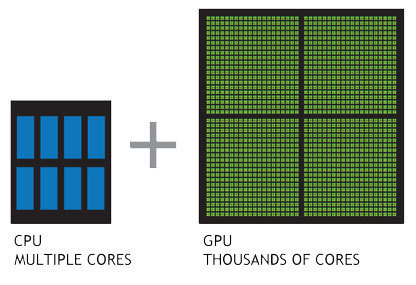



MODERN DEEP LEARNING
Several key advancements have enabled the modern deep learning revolution
Advent of massively parallel computing by GPUs. Enabled training of huge neural nets on extremely large datasets





Several key advancements have enabled the modern deep learning revolution
Methodological advancements have made deeper networks easier to train

Architecture

Optimizers

Activation Functions

MODERN DEEP LEARNING
Several key advancements have enabled the modern deep learning revolution
Robust frameworks and abstractions make iteration faster and less error prone
Automatic differentiation allows easy prototyping



MODERN DEEP LEARNING

+
NEURAL NETS FROM A STATISTICAL PERSPECTIVE

NEURAL NETS

- Neural nets can look strange until you internalize the jargon and what they are doing
- Related to several well-known statistical models
- Misconception: Neural nets work because they are super flexible black boxes
- Reality: Neural nets works because they allow you to incorporate problem-specific constraints very easily and they scale really well
WHY DOES DEEP LEARNING WORK?


https://simplystatistics.org/2017/05/31/deeplearning-vs-leekasso/
WHY DOES DEEP LEARNING WORK?


https://simplystatistics.org/2017/05/31/deeplearning-vs-leekasso/
WHY DOES DEEP LEARNING WORK?

http://beamandrew.github.io/deeplearning/2017/06/04/deep_learning_works.html

WHY DOES DEEP LEARNING WORK?



http://beamandrew.github.io/deeplearning/2017/06/04/deep_learning_works.html
NEURAL NETS REVISITED

Neural nets are always presented in terms of units and layers, but everything can be written in terms of matrix multiplications and element wise operations
NEURAL NETS REVISITED

Neural nets are always presented in terms of units and layers, but everything can be written in terms of matrix multiplications and element wise operations
Recall, a hidden layer does a linear rotation, followed by a nonlinear element-wise transformation
NEURAL NETS REVISITED

Neural nets are always presented in terms of units and layers, but everything can be written in terms of matrix multiplications and element wise operations
Recall, a hidden layer does a linear rotation, followed by a nonlinear element-wise transformation
Given
NEURAL NETS REVISITED

Neural nets are always presented in terms of units and layers, but everything can be written in terms of matrix multiplications and element wise operations
Recall, a hidden layer does a linear rotation, followed by a nonlinear element-wise transformation
Given
Hidden layer is
NEURAL NETS REVISITED

Neural nets are always presented in terms of units and layers, but everything can be written in terms of matrix multiplications and element wise operations
Recall, a hidden layer does a linear rotation, followed by a nonlinear element-wise transformation
Given
Hidden layer is
Output layer is
NEURAL NETS REVISITED

A network with two hidden layers is:
NEURAL NETS REVISITED

A network with two hidden layers is:
In general, layers represent a recursive relationship:
NEURAL NETS REVISITED

Some connections to other models:
- A neural net with no hidden layers = logistic regression
- "Neurons" are really simple, but really weird basis functions
Closely related to generalized additive models (GAM), especially projection pursuit regression (Friedman, 1981)
- Bayesian neural networks: Normal prior on each weight, as number of hidden units -> infinity you recover a Gaussian process (Neal, 1996)
NEURAL NETS REVISITED

So what's the big deal?
NEURAL NETS REVISITED

So what's the big deal?
- Neural nets offer many key advantages in computation, optimization, and regularization
NEURAL NETS REVISITED

So what's the big deal?
- Neural nets offer many key advantages in computation, optimization, and regularization
- Computation: GPUs are exceedingly good at linear algebra -> train big models fast
NEURAL NETS REVISITED

So what's the big deal?
- Neural nets offer many key advantages in computation, optimization, and regularization
- Computation: GPUs are exceedingly good at linear algebra -> train big models fast
- Optimization: Variants of SGD "work" very well on a variety of networks and problems
NEURAL NETS REVISITED

So what's the big deal?
- Neural nets offer many key advantages in computation, optimization, and regularization
- Computation: GPUs are exceedingly good at linear algebra -> train big models fast
- Optimization: Variants of SGD "work" very well on a variety of networks and problems
- Regularization: Neural nets are regularized in dozens of ways explicitly and implicitly to reduce variance
Regularization

REGULARIZATION

Neural nets represent the following optimization problem:
where
REGULARIZATION

A familiar way to regularize is introduce penalties and change
REGULARIZATION

A familiar why to regularize is introduce penalties and change
to
REGULARIZATION

A familiar why to regularize is introduce penalties and change
to
where R(W) is often the L1 or L2 norm of W. These are the well known ridge and LASSO penalties, referred to as weight decay by neural net community
STOCHASTIC REGULARIZATION

Often, we will inject noise into the neural network during training. By far the most popular way to do this is dropout
STOCHASTIC REGULARIZATION

Often, we will inject noise into the neural network during training. By far the most popular way to do this is dropout
Given a hidden layer H(X), we are going to set each element of H(X) to 0 with probability p each SGD update.

STOCHASTIC REGULARIZATION

One way to think of this is the network is trained by bagged versions of the network. Bagging reduces variance.
STOCHASTIC REGULARIZATION

One way to think of this is the network is trained by bagged versions of the network. Bagging reduces variance.
Others have argued this is an approximate Bayesian model

STOCHASTIC REGULARIZATION

Many have argued that SGD itself provides regularization
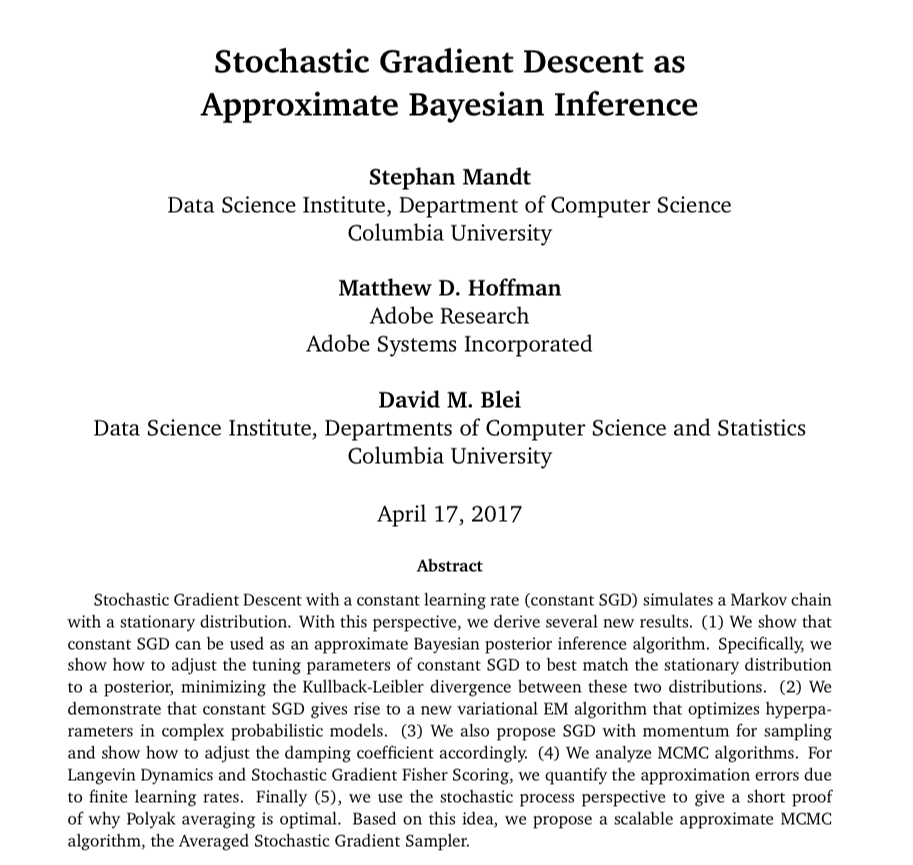
STOCHASTIC REGULARIZATION

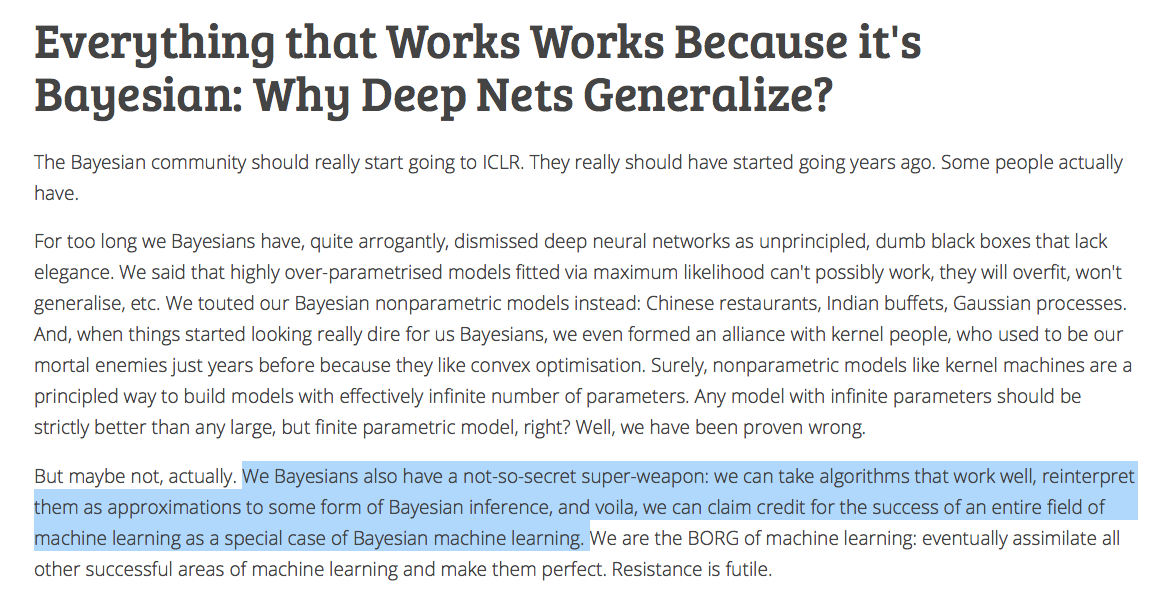
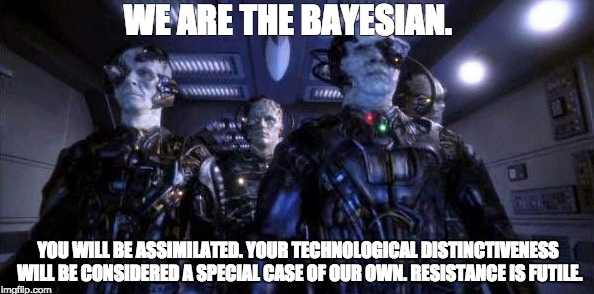
http://www.inference.vc/
INITIALIZATION REGULARIZATION

The weights in a neural network are given random values initially
INITIALIZATION REGULARIZATION

The weights in a neural network are given random values initially
There is an entire literature on the best way to do this initialization
INITIALIZATION REGULARIZATION

The weights in a neural network are given random values initially
There is an entire literature on the best way to do this initialization
- Normal
- Truncated Normal
- Uniform
- Orthogonal
- Scaled by number of connections
- etc
INITIALIZATION REGULARIZATION

Try to "bias" the model into initial configurations that are easier to train
INITIALIZATION REGULARIZATION

Try to "bias" the model into initial configurations that are easier to train
Very popular way is to do transfer learning
INITIALIZATION REGULARIZATION

Try to "bias" the model into initial configurations that are easier to train
Very popular way is to do transfer learning
Train model on auxiliary task where lots of data is available

INITIALIZATION REGULARIZATION

Try to "bias" the model into initial configurations that are easier to train
Very popular way is to do transfer learning
Train model on auxiliary task where lots of data is available

Use final weight values from previous task as initial values and "fine tune" on primary task

STRUCTURAL REGULARIZATION

However, the key advantage of neural nets is the ability to easily include properties of the data directly into the model through the network's structure
Convolutional neural networks (CNNs) are a prime example of this
CONVOLUTIONAL NEURAL NETWORKS

CONVOLUTIONAL NEURAL NETS (CNNs)

Dates back to the late 1980s
- Invented by in 1989 Yann Lecun at Bell Labs - "Lenet"
- Integrated into handwriting recognition systems
in the 90s - Huge flurry of activity after the Alexnet paper


THE BREAKTHROUGH (2012)

Imagenet Database
- Millions of labeled images
- Objects in images fall into 1 of a possible 1,000 categories
- Relatively high-resolution
- Bounding boxes giving exact location of object - useful for both classification and localization
Large Scale Visual
Recognition Challenge (ILSVRC)
- Annual Imagenet Challenge starting in 2010
- Successor to smaller PASCAL VOC challenge
- Many tracks including classification and localization
- Standardized training and test set. Competitors upload predictions for test set and are automatically scored
THE BREAKTHROUGH (2012)

In 2011, a misclassification rate of 25% was near state of the art on ILSVRC
In 2012, Geoff Hinton and two graduate students, Alex Krizhevsky and Ilya Sutskever, entered ILSVRC with one of the first deep neural networks trained on GPUs, now known as "Alexnet"
Result: An error rate of 16%, nearly half what the second place entry was able to achieve.
The computer vision world immediately took notice
THE ILSVRC AFTERMATH (2012-2014)


Alexnet paper has ~ 16,000 citations since being published in 2012!
Most algorithms expect "tabular" data

WHY CNNS WORK
| y | X1 | X2 | X3 | X4 |
|---|---|---|---|---|
| 0 | 7 | 52 | 17 | 654 |
| 0 | 23 | 2752 | 4 | 1 |
| 1 | 786 | 27 | 0 | 5 |
| 0 | 354 | 7527 | 89 | 68 |
The problem with tabular data


What is this a picture of?
WHY CNNS WORK

What is this a picture of?

The problem with tabular data
WHY CNNS WORK

What is this a picture of?

Tabular data throws away too much information!
The problem with tabular data
WHY CNNS WORK
CONVOLUTIONAL NEURAL NETS

Images are just 2D arrays of numbers

Goal is to build f(image) = 1
CONVOLUTIONAL NEURAL NETS

CNNs look at small connected groups of pixels using "filters"

Image credit: http://deeplearning.stanford.edu/wiki/index.php/Feature_extraction_using_convolution
Images have a local correlation structure
Near by pixels are likely to be more similar than pixels that are far away
CNNs exploit this through convolutions of small image patches
CONVOLUTIONAL NEURAL NETS

Example convolution

CONVOLUTIONAL NEURAL NETS

Pooling provides spatial invariance

Image credit: http://cs231n.github.io/convolutional-networks/
CONVOLUTIONAL NEURAL NETS

Convolution + pooling + activation = CNN

Image credit: http://cs231n.github.io/convolutional-networks/


CONVOLUTIONAL NEURAL NETS (CNNs)

CNN formula is relatively simple
Image credit: http://cs231n.github.io/convolutional-networks/

CONVOLUTIONAL NEURAL NETS

Data augmentation mimics the image generative process
Image credit: http://slideplayer.com/slide/8370683/

- Drastically "expands" training set size
- Improves generalization
- Works if it doesn't "break" image -> label relationship
WHY DO CNNs WORK SO WELL?

- Based on solid image priors
- Exploit properties of images, e.g. local correlations and invariances
- Mimic generative distribution with augmentation to reduce over fitting
- Results in end-to-end visual recognition system trained with SGD on GPUs: pixels in -> classifications out
CNNs exploit strong prior information about images
SUMMARY & CONCLUSIONS

DEEP LEARNING AND YOU
Barrier to entry for deep learning is actually low

... but a few things might stand in your way:
- Need to make sure your problem is a good fit
- Lots of labeled data and appropriate signal/noise ratio
- Access to GPUs
- Must "speak the language"
- Many design choices and hyper parameter selections
- Know how to "babysit" the model during learning phase
CONCLUSIONS

- Could potentially impact many fields -> understand concepts so you have deep learning "insurance"
- Many connections to other models
- Prereqs: Data (lots) + GPUs (more = better)
- Easy incorporate problem structure directly into model
- Drastic amounts of regularization
- Deep learning models are like legos, but you need to know what blocks you have and how they fit together